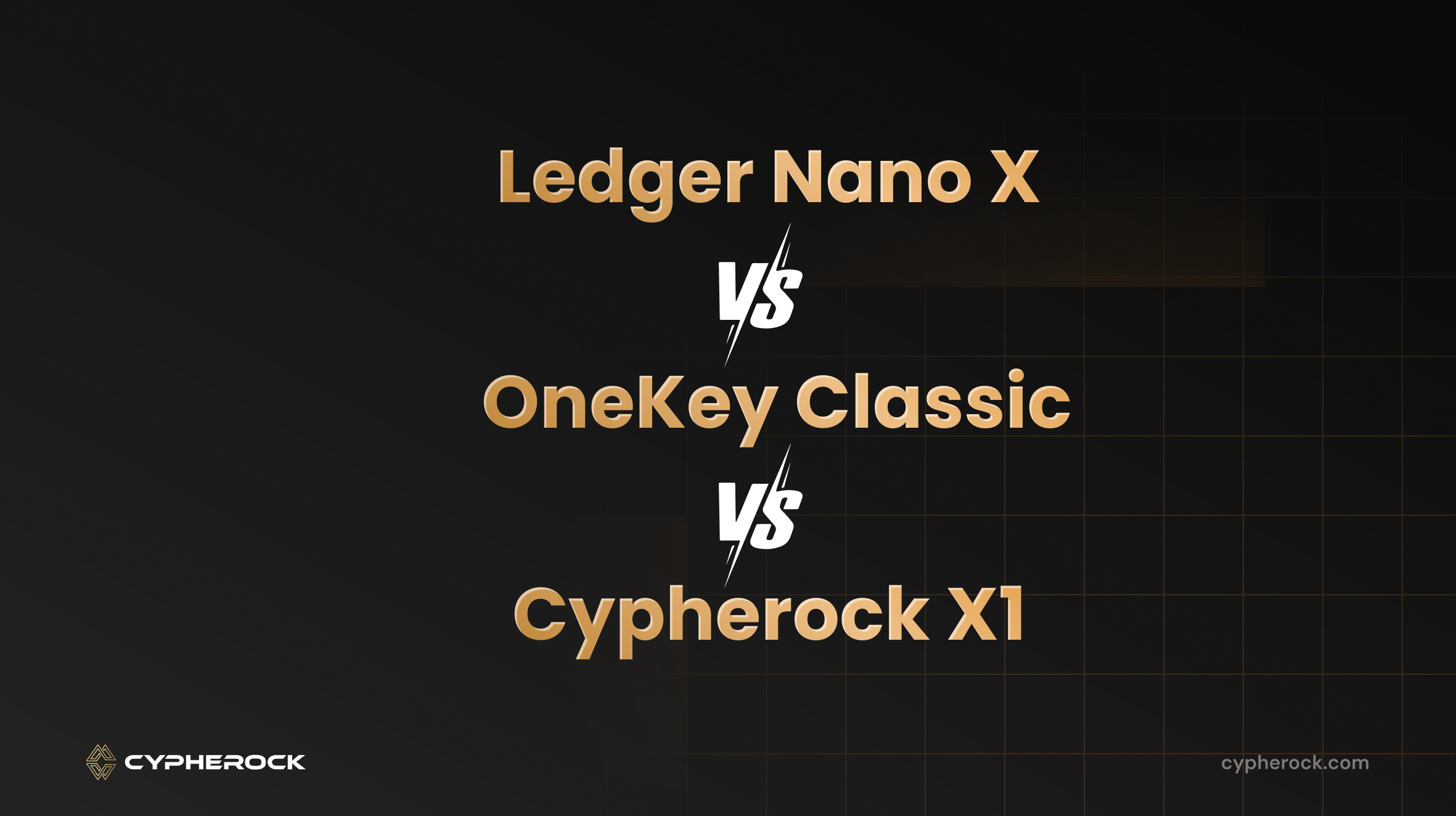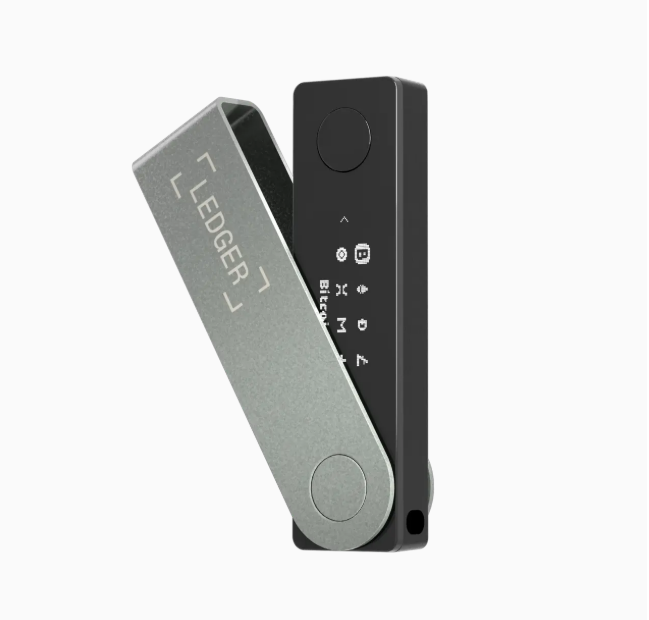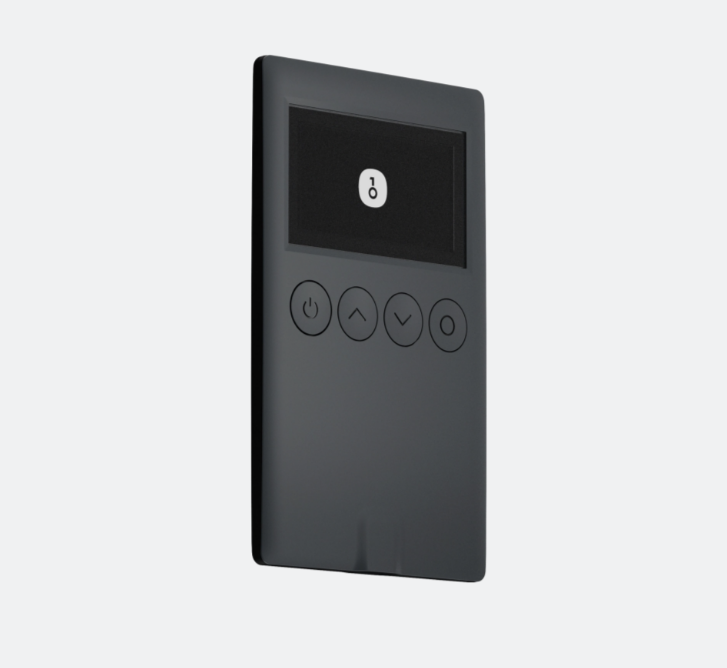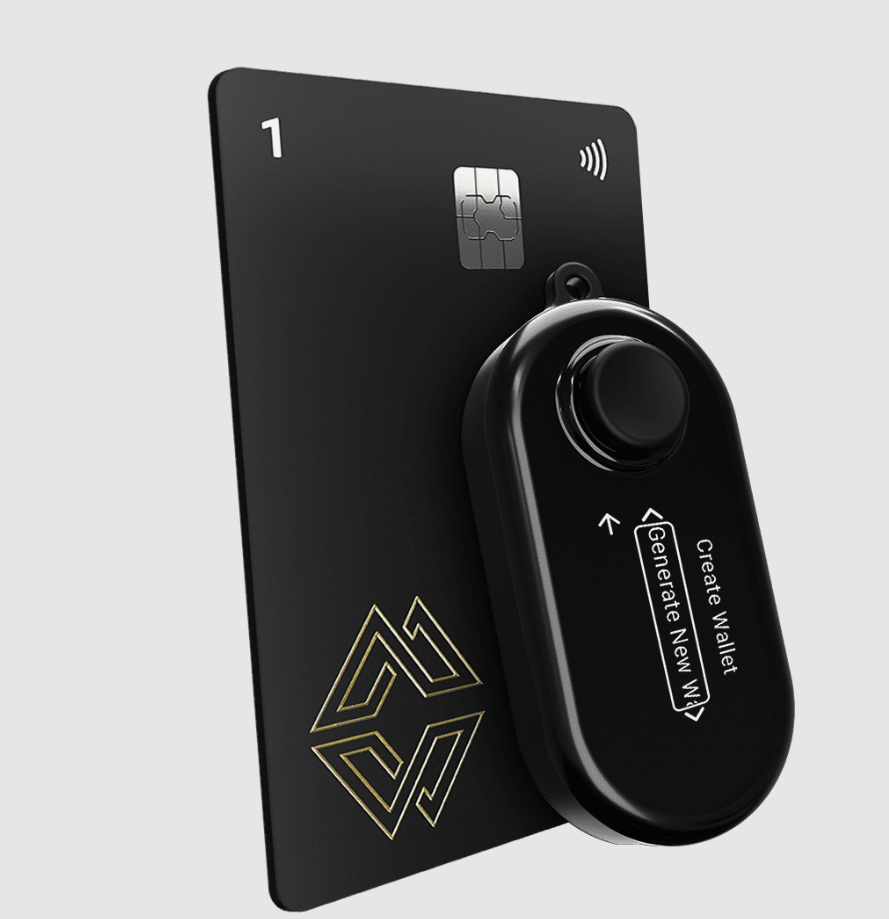

Cryptocurrency has exploded in popularity in recent years. As more people invest in digital currencies like Bitcoin, Ethereum, and others, it’s important to ensure that these digital assets are kept secure. One of the best ways to protect your cryptocurrencies from theft or loss is by using a hardware wallet.
A hardware wallet is a physical device that stores your private keys (the password that proves you own your cryptocurrency) offline. This makes it far more secure than online wallets, which can be hacked if your internet connection is compromised. Hardware wallets are often called "cold storage" because they are not connected to the internet, reducing the risk of cyberattacks.
In this article, we will compare three popular hardware wallets: the Ledger Nano X, OneKey, and Cypherock X1. We’ll discuss their designs, security features, backup methods, and much more to help you decide which one suits your needs the best.
When you choose a hardware wallet, you should consider the design, size, and overall feel of the device. After all, it’s something you will carry around or keep secure at all times. A good design will make the wallet easier to use, while also ensuring it’s portable and durable.
The Ledger Nano X is one of the most popular hardware wallets available today. It is a small, compact device that is easy to carry around. Weighing only 34 grams, it’s light enough to slip into your pocket or bag. Its sleek design includes a small screen and two buttons that allow you to navigate through the settings and transactions.
One of the Ledger Nano X's key features is Bluetooth connectivity, which lets you manage your wallet directly from your smartphone or tablet without the need for cables. This makes it more convenient than previous models, like the Ledger Nano S, which required a USB connection. However, some users find that the small screen and button navigation can be tricky at first, especially if you’re new to hardware wallets.

OneKey offers a completely different design philosophy. It’s ultra-light, weighing only 20 grams, and it’s incredibly thin, measuring just 5.2 mm thick. Despite its small size, it has a larger screen compared to other hardware wallets, which makes it easier to read transaction details and wallet addresses.
The device uses four physical buttons for easy navigation, ensuring you don’t need to worry about accidental presses. This makes OneKey particularly user-friendly for those who are new to hardware wallets or crypto in general.
OneKey is compact, making it perfect for people who value portability and ease of use. Its lightweight design makes it ideal for travelers or anyone who wants to manage their crypto on the go.

Cypherock X1 is a hardware wallet that takes a security-first approach with a distributed architecture, addressing the vulnerabilities found in traditional hardware wallets. It uses advanced cryptography and purpose-built hardware to ensure your assets are protected at the highest level.
At the core of its design is Shamir’s Secret Sharing (SSS) cryptography, which splits your private key into five distinct shards using a mathematically secure threshold scheme. Each X1 Card is equipped with an EAL 6+ secure element—the same technology used in banking cards—offering tamper-resistant storage for these key shards.
With a 2-of-5 threshold security model, you need exactly two of the five shards to reconstruct your private key, providing a balance of security and redundancy. The X1 Vault further strengthens security with its dual-chip architecture, where one secure element handles offline computations and the other manages verification, ensuring robust defense in depth.
Cypherock X1 also features a non-custodial inheritance protocol, built into the cryptographic architecture, allowing for recovery without compromising its zero-trust security model.
As a security-conscious user, you can trust that Cypherock X1 has undergone rigorous audits by KeyLabs—the same firm that discovered vulnerabilities in both Ledger and Trezor devices.
For more detailed guidance on using the Cypherock X1, check out our comprehensive guide on how to use Cypherock.

Security is the most important factor when choosing a hardware wallet, and each of these devices takes different approaches to keeping your crypto safe.
The Ledger Nano X is a highly secure wallet, thanks to its use of a secure chip (CC EAL5+). This chip is a trusted industry standard that is also used in credit cards and other sensitive devices. It ensures that your private keys are stored safely and that your transactions are protected.
However, one of the biggest drawbacks of the Ledger Nano X is its reliance on the recovery seed phrase. While this is a widely accepted backup method, it can be a risk if the seed phrase is not stored securely. If someone else gains access to your seed phrase, they could steal your crypto. So, it’s important to keep your seed phrase in a safe place, like a vault or a secure offline location.
Moreover, Ledger faced a significant breach in 2023, where customer data was compromised due to a hack that exposed personal details linked to customers' crypto wallets. While the hack did not affect the wallet’s security directly, it raised concerns about data leaks, highlighting the importance of security measures beyond just the device itself. Ledger Hack 2023 - A Wake-Up Call.
OneKey also takes security seriously. It uses a Secure Element (SE) chip for storing sensitive information, and it supports FIDO2 authentication for online security. FIDO2 is a passwordless authentication standard that ensures your device is the only one capable of authorizing transactions. OneKey’s open-source software is another plus because it allows the community to audit the code and ensure there are no hidden vulnerabilities.
However, OneKey also faced a security concern in 2023, with a reported vulnerability that exposed users to risks, particularly around its recovery seed. Although it was quickly addressed by the team, this incident drew attention to the risks inherent in open-source designs, where vulnerabilities may be uncovered and exploited before a fix is implemented. OneKey Hack Information.
The Cypherock X1 takes security to the next level with its advanced cryptographic architecture. Using Shamir's Secret Sharing (SSS), the X1 splits your private key into five separate shards. Each shard is securely stored on the X1 Vault and X1 Cards. To recover your crypto, you only need two shards, ensuring there’s no single point of failure. This approach greatly enhances security compared to traditional hardware wallets.
Moreover, Cypherock X1 uses EAL6+ certified secure elements—bank-grade technology that ensures tamper-resistant storage for your key shards. Even if someone gains access to your device, they cannot access your crypto unless they have both your PIN and two parts of your key, providing multiple layers of protection.
For more in-depth information on Cypherock's advanced security features, check out our article on how Cypherock X1 enhances security.
Losing access to your wallet can be a nightmare, so it’s essential to understand how each wallet handles backups and recovery.
The Ledger Nano X uses a traditional recovery seed phrase as a backup. If your wallet is lost or stolen, you can recover your funds by entering this phrase into a new Ledger device. However, the security of this backup depends entirely on how securely you store the seed phrase. If someone finds it, they can steal your crypto.
OneKey also uses a recovery seed phrase, but it offers more flexibility. You can choose between a 12, 18, or 24-word phrase, which allows for a higher level of security, especially if you opt for the 24-word option. The device is simple to recover, and the process is relatively quick, which is useful if you’re in a hurry to regain access to your funds.
Cypherock X1 takes a revolutionary approach to key backup by eliminating the traditional seed phrase. Instead, it utilizes Shamir's Secret Sharing (SSS) to split your private key into five parts, with at least two parts required for recovery.
This advanced method removes the need for paper backups, which are vulnerable to loss, theft, or damage. If you ever lose your Cypherock X1 device, you can still access your funds as long as you have two of the five key parts, ensuring a secure and decentralized backup solution.
For more information on Cypherock’s decentralized backup and recovery method, check out how Cypherock’s decentralized backup works.
While security is the top priority, usability is important too. Let’s take a look at how easy it is to set up and use each of these wallets.
The Ledger Nano X is user-friendly, especially if you’re familiar with the Ledger Live app, which makes managing your crypto assets a breeze. The app is available for both desktop and mobile devices, so you can easily access your wallet from anywhere. However, some users find it tricky to navigate the wallet on the device itself, as it relies on a two-button setup for navigating through the settings and approving transactions.
OneKey is designed with simplicity in mind. The device has a large, easy-to-read screen and four physical buttons, making it easy to navigate. The OneKey app is straightforward, and even beginners can set it up and use it without trouble. It’s ideal for those who are new to hardware wallets and don’t want to get bogged down with complicated setup processes.
The Cypherock X1 is designed with a focus on both cutting-edge security and usability. While it may feel more complex for beginners, the intuitive interface and innovative NFC-enabled cards make it highly user-friendly once you become familiar with its features.
By simply tapping a card on the X1 Vault, you can quickly complete transactions, offering both speed and ease. While it may take a moment to adjust to Cypherock X1’s unique, security-first design, the learning curve is worth the enhanced protection it offers for your crypto assets.
When it comes to cryptocurrency, transparency is key. Let’s look at how each wallet handles firmware transparency.
Ledger Nano X has closed-source firmware, which means that the code is not open for public inspection. However, it has undergone multiple security audits and is widely regarded as a secure option.
OneKey is open-source, meaning anyone can audit the code for vulnerabilities. This transparency is a big selling point for people who want to ensure there are no hidden backdoors in their wallet’s firmware.
Similar to OneKey, the Cypherock X1 is open-source, allowing the community to review the code and verify that it is free from vulnerabilities. This transparency ensures that the wallet’s operations, particularly those involving private keys, can be independently audited. However, Cypherock X1 also employs a unique approach by balancing open-source transparency with proprietary security. The X1 Vault’s code is open-source for community inspection, while the X1 Cards’ code is proprietary, providing enhanced security through EAL6+ certified secure elements.
One of the most important factors to consider when choosing a hardware wallet is the range of cryptocurrencies and blockchains it supports. A good wallet should be able to manage the coins and tokens you’re most interested in, whether they are major cryptocurrencies like Bitcoin and Ethereum or smaller altcoins.
The Ledger Nano X is one of the most versatile wallets available in terms of coin and blockchain support. It can handle over 5,500 cryptocurrencies, including Bitcoin, Ethereum, Solana, and many ERC-20 tokens. This makes it an excellent choice for users who hold a wide variety of assets or plan to diversify their portfolio in the future.
Additionally, the Ledger Live app supports staking for some coins, which allows you to earn rewards on your holdings by helping secure certain blockchains. This feature is especially appealing for users who want to get the most out of their investments.
For a list of supported coins, check out Ledger’s official page to see if your favorite cryptocurrency is included.
OneKey is also highly compatible with many cryptocurrencies. It supports over 43 blockchains and thousands of tokens, including Bitcoin, Ethereum, and most major altcoins. Its Web3 and DeFi integrations make it an ideal choice for users who are actively engaged in decentralized finance or managing a diverse portfolio of digital assets.
While OneKey doesn’t support as many coins as Ledger Nano X, it covers all the most popular ones and supports a wide range of decentralized applications (DApps), making it a solid option for those who are more focused on the basics and DeFi.
For a list of supported assets, you can check the OneKey website or app for updates.
The Cypherock X1 also supports over 9,000 cryptocurrencies, which makes it highly versatile in terms of asset compatibility. This wallet is ideal for users who hold a variety of tokens, from major cryptocurrencies like Bitcoin and Ethereum to lesser-known altcoins and DeFi tokens.
The Cypherock X1 integrates well with WalletConnect, allowing users to interact with decentralized applications (DApps) and Web3 services. This compatibility means you can seamlessly manage your portfolio and engage in the DeFi ecosystem, while still keeping your assets safe and offline.
Cypherock also provides compatibility with multiple blockchains, making it a great option for users with a wide range of assets.
For more on supported coins and blockchain networks, visit Cypherock Coin Support to explore asset compatibility.
The companion app that works with your hardware wallet is critical to managing your crypto portfolio, checking balances, and making transactions. Let’s look at how the apps for Ledger Nano X, OneKey, and Cypherock X1 compare.
The Ledger Nano X relies on the Ledger Live app, which is available for both desktop and mobile. The app is designed to provide a simple, user-friendly interface that makes managing your crypto assets easy. It allows you to check your balance, send and receive cryptocurrencies, and even buy crypto directly through the app using Coinify and MoonPay partnerships.
In addition to handling day-to-day transactions, Ledger Live supports staking for some of the popular Proof-of-Stake assets like Polkadot, Tezos, and Solana. While the app is very well designed and intuitive, some users may find it a bit overwhelming if they are new to crypto, especially with all of the additional features and options it offers.
For a detailed review of the Ledger Live app, check out our guide on Ledger Live setup and features.
The OneKey app is extremely user-friendly. It is available for both mobile devices and desktop, providing a simple interface to manage your assets. OneKey doesn’t overwhelm you with too many advanced features, which makes it perfect for beginners. The app allows you to check balances, make transactions, and easily connect to decentralized applications (DApps) and Web3 platforms.
The OneKey app is open-source, which allows users to inspect the code and ensure there are no hidden vulnerabilities or security issues. OneKey prioritizes ease of use, and the app reflects that focus. However, it lacks some of the advanced features that Ledger Live offers, like staking, which might be a dealbreaker for more experienced users.
For a deeper look into OneKey’s app and its features, check out OneKey's app guide.
The Cypherock X1 integrates seamlessly with the cySync app, available on Windows, Mac, Linux, Android, and iOS. Built with simplicity and usability in mind, the app offers an intuitive interface that empowers users to manage their crypto securely and efficiently.
Designed to complement Cypherock’s advanced security architecture, cySync allows users to manage up to four independent wallets, ideal for those diversifying across multiple crypto portfolios.
CySync also supports WalletConnect, enabling users to securely interact with DeFi platforms and decentralized applications (DApps) while maintaining full control over their private keys through Cypherock’s secure hardware.
If you have significant crypto holdings or want to manage assets for a family or team, multi-wallet support and inheritance options are important features to consider.
Ledger Recover is Ledger’s optional subscription-based backup service designed to help users regain access to their wallets—even if the physical device is lost. Branded as a “digital spare key,” Ledger Recover links your identity to your recovery setup. It creates an encrypted backup of your Secret Recovery Phrase, splits it into three parts inside your Ledger’s Secure Element, and securely distributes them across Hardware Security Modules (HSMs) managed by independent providers in different countries.
To restore access, users simply verify their identity through the Ledger Live app—no need to rely on fragile paper backups. This service is particularly geared toward users looking for peace of mind and easier recovery, though it does require trust in third-party identity verification and encrypted cloud storage managed in part by Coincover.
While it introduces a more convenient path for recovery, it also marks a shift from the fully self-custodial model, raising questions about balancing user convenience with true decentralization and control.
OneKey offers multi-wallet support, so you can store and manage different crypto assets in separate wallets. However, OneKey does not currently offer any inheritance features. If you want to share access to your wallet with others, you’ll need to use the recovery seed phrase, which could be a problem if the seed phrase is lost or compromised.
OneKey is more geared toward individual users or small families rather than business users or those planning for inheritance.
Cypherock X1 stands out as a next-generation hardware wallet designed not only for secure crypto storage but also for seamless inheritance and multi-wallet management. Supporting up to four independent wallets, Cypherock X1 allows you to segregate assets for personal, business, or family use—each with its own secure recovery mechanism.
Cypherock Cover builds on this architecture to offer the world’s most secure non-custodial and non-KYC crypto estate planning solution. With Cover, you can plan for crypto inheritance and PIN recovery without ever exposing your seed phrase or compromising on the web3 ethos. Whether you're preparing for unforeseen circumstances or simply want to future-proof your crypto legacy, Cypherock Cover ensures your loved ones can access your assets—while you retain full control during your lifetime.
Cypherock uses Shamir’s Secret Sharing to split your private key into five shards stored across the X1 Vault and X1 Cards. With 2-of-5 threshold recovery, your crypto remains safe even if the device is lost or damaged. Combined with PIN Recovery and Estate Recovery via Cypherock Cover, this setup eliminates the risk of single points of failure and simplifies recovery—without needing legal documents, KYC, or trust in a third party.
With features like:
Cypherock X1 + Cover redefines what it means to truly own and protect your crypto—for today and for generations to come.
Explore more about Cypherock Cover here.

Here’s a quick summary of the strengths and weaknesses of each wallet to help you make a more informed decision.
When it comes to securing your crypto assets, the choice of hardware wallet ultimately depends on your needs, whether it's advanced security, multi-wallet management, or inheritance planning.
Ledger Nano X is a solid choice for individuals looking for a compact, secure wallet with Bluetooth connectivity and strong coin support. Its trusted EAL5+ secure chip ensures safety, though its reliance on a recovery seed phrase and lack of built-in inheritance features might be a limitation for users planning for the future or seeking added peace of mind.
OneKey Classic stands out for its user-friendly, open-source design, making it an excellent option for beginners. It’s lightweight, portable, and easy to navigate, but it lacks inheritance features and has limited support for advanced crypto functionalities like staking. This makes it better suited for simpler portfolios or individuals focused on decentralized finance (DeFi).
Cypherock X1 takes a more innovative approach by using Shamir's Secret Sharing for key management, eliminating the vulnerability of seed phrases. With support for up to four wallets, non-custodial inheritance features, and advanced security like EAL6+ secure elements, Cypherock X1 is ideal for users looking for the highest levels of security and future-proofing for their crypto legacy. The integration of Cypherock Cover ensures your assets are accessible to loved ones without compromising on security, making it the best choice for those who prioritize long-term protection and inheritance planning.
In conclusion, for security-conscious individuals or families who want full control over their crypto assets—without relying on third parties—Cypherock X1 with Cypherock Cover is the most comprehensive solution available. For those seeking a balance between ease of use and security, Ledger Nano X provides a familiar and reliable option, while OneKey Classic remains an excellent choice for those just starting their crypto journey.
Each of these wallets offers a unique set of features and trade-offs. Your choice should depend on your priorities—whether it’s convenience, security, or long-term estate planning.
Start securing your crypto journey today—visit Cypherock X1 to learn more.
Connect with us:
Twitter: @CypherockWallet
Telegram: Join the Community
